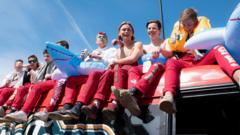Norwegian school-leavers, known as russ, are synonymous with vibrant red overalls and exuberant celebrations as they near graduation. However, traditions surrounding this rite of passage have evolved into a phenomenon that raises red flags for many parents and local authorities. As the countdown to Norway's national day on May 17 approaches, students like 18-year-old Selma Jenvin-Steinsvag and her classmate Aksel hurry to catch the metro, excitedly declaring that they are finished with exams.
The festivities, while cherished, have grown concerning, especially with the rise of the russebuss culture. This tradition involves rented party buses where students revel nightly for weeks before exams, leading to excessive drinking and drug use, along with significant financial strain as many students take on debts to afford the costs. "We party all night with loud music, it's just fun!" said Edvard Aanestad, emphasizing the intensity of the experience. Yet, this merry-making is having a negative impact on young people's health and academic performance, with increased peer pressure and financial exclusion also leading to worries.
Recent comments from Norwegian Prime Minister Jonas Gahr Store represent a growing sentiment that the tradition has spiraled out of control. Local parents, such as Solveig Haukenes Aase, now advocate for safer environments for youngsters, highlighting how the russefeiring (celebration) has begun to influence even younger children, creating a wider culture of excess that threatens academic integrity. Education minister Kari Nessa Nordtun acknowledged these issues, shedding light on the intertwining of celebrations and exam stress, and advocated for a more inclusive approach to such celebrations.
Efforts are underway to move these parties post-exams starting next year, a suggestion supported by many but met with resistance from the youth themselves. Critics, including Edvard, argue that such sweeping changes would not effectively tackle the root issues of inequality and exclusion. The government also aims to ban certain unsafe aspects of the buses, such as sideways seating, a move seen by some as unnecessary and counterproductive.
This vibrant tradition, rooted in elite Oslo schools since the 1980s, has burgeoned into a national spectacle, deeply embedded in Norwegian culture. Yet, the high cost and selective nature of modern celebrations raise pressing questions about their future, safety, and inclusivity, leaving many wondering how best to preserve the spirit of togetherness while ensuring the well-being of students.
The festivities, while cherished, have grown concerning, especially with the rise of the russebuss culture. This tradition involves rented party buses where students revel nightly for weeks before exams, leading to excessive drinking and drug use, along with significant financial strain as many students take on debts to afford the costs. "We party all night with loud music, it's just fun!" said Edvard Aanestad, emphasizing the intensity of the experience. Yet, this merry-making is having a negative impact on young people's health and academic performance, with increased peer pressure and financial exclusion also leading to worries.
Recent comments from Norwegian Prime Minister Jonas Gahr Store represent a growing sentiment that the tradition has spiraled out of control. Local parents, such as Solveig Haukenes Aase, now advocate for safer environments for youngsters, highlighting how the russefeiring (celebration) has begun to influence even younger children, creating a wider culture of excess that threatens academic integrity. Education minister Kari Nessa Nordtun acknowledged these issues, shedding light on the intertwining of celebrations and exam stress, and advocated for a more inclusive approach to such celebrations.
Efforts are underway to move these parties post-exams starting next year, a suggestion supported by many but met with resistance from the youth themselves. Critics, including Edvard, argue that such sweeping changes would not effectively tackle the root issues of inequality and exclusion. The government also aims to ban certain unsafe aspects of the buses, such as sideways seating, a move seen by some as unnecessary and counterproductive.
This vibrant tradition, rooted in elite Oslo schools since the 1980s, has burgeoned into a national spectacle, deeply embedded in Norwegian culture. Yet, the high cost and selective nature of modern celebrations raise pressing questions about their future, safety, and inclusivity, leaving many wondering how best to preserve the spirit of togetherness while ensuring the well-being of students.






















